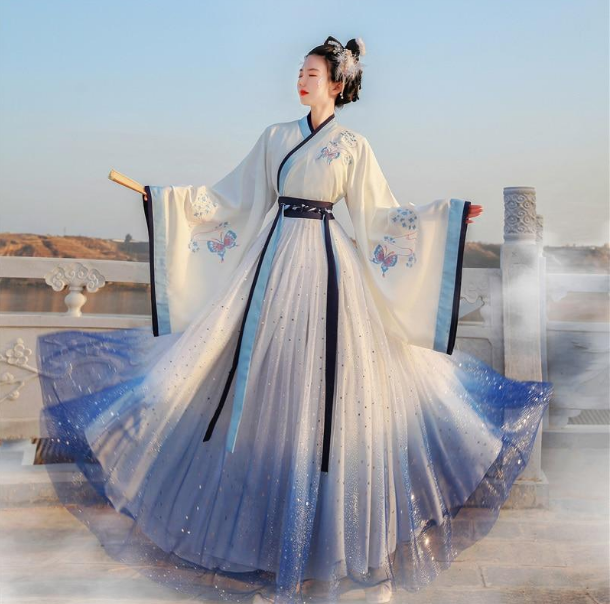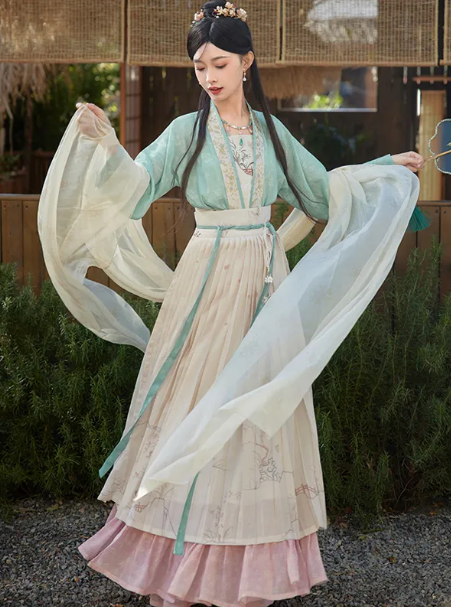Introduction to Hanfu
Hanfu, the traditional attire of the Han Chinese, represents more than just clothing. It embodies a rich cultural heritage, historical significance, and a deep-seated respect for traditions.
Definition and Historical Background
Hanfu dates back to the earliest dynasties of China, evolving over millennia. Its name, “Hanfu,” directly links to the Han ethnicity, China’s largest ethnic group. As explored in the Han Dynasty history, Hanfu wasn’t merely a fashion statement; it symbolized status, cultural identity, and social beliefs.

Evolution and Significance in Chinese Culture
Hanfu’s evolution mirrors the changes in Chinese dynastic eras. From the simple, straight-lined robes of the Shang Dynasty to the ornate, layered garments of the Tang Dynasty, each style reflects the societal, economic, and cultural shifts of its time. Hanfu holds a significant place in Chinese culture, not just as a clothing style, but as a symbol of the rich tapestry of Chinese history and arts.
The Historical Roots of Hanfu
The history of Hanfu delves deep into China’s past, tracing the story of a civilization through its attire.
Origin in Ancient China
Hanfu originated in the early dynasties of ancient China, with the earliest examples dating back to the Huangdi period. Legends attribute its design to the Yellow Emperor, making it a cornerstone of Han cultural identity. The robes, designed to respect traditional Confucian values, highlighted modesty and propriety.
Changes Through Dynasties
As dynasties rose and fell, Hanfu styles evolved dramatically. The Shang Dynasty favored narrow-sleeved, straight-cut robes. In contrast, the Tang Dynasty introduced wider sleeves, vibrant colors, and a preference for silk, reflecting the era’s prosperity and openness to foreign influences. The Ming Dynasty saw a return to traditionalism, simplifying Hanfu to display national identity and resistance to foreign rule. Each change in Hanfu directly aligned with the shifts in societal values, economic conditions, and ruling philosophies, deeply intertwining clothing with history and culture.
Components and Characteristics of Traditional Hanfu
Traditional Hanfu reflects a profound cultural heritage through its unique components and characteristics.
Styles, Fabrics, and Patterns
Hanfu styles typically include the Yi, a narrow-cuffed, knee-length tunic tied with a sash, and the Shang, a skirt or trousers worn underneath. These elements combine grace with practicality, showcasing a blend of aesthetics and comfort. Silk, the most cherished fabric, symbolizes wealth and status, while cotton, more affordable, caters to the common populace. The patterns often incorporate symbolic motifs like dragons, phoenixes, and floral designs, each carrying distinct meanings and conveying messages about the wearer’s social status, aspirations, and virtues.
Symbolism in Designs and Colors
Colors in Hanfu aren’t merely aesthetic; they embody deep symbolism. Red, representing happiness and fortune, often appears in festival attire and wedding gowns. Blue signifies serenity and integrity, reflecting the Confucian value of righteousness. Yellow, historically reserved for the emperor, symbolizes power and centrality in the universe. These colors, combined with the designs, craft not just a garment but a tapestry of Chinese philosophic and moral thinking, deeply embedded in every thread of Hanfu.
Hanfu Vs. Other Traditional Chinese Attires
Comparing Hanfu with other Chinese traditional clothing reveals distinct cultural and historical differences.
Differences from Qipao and Other Ethnic Costumes
Hanfu, typically featuring cross-collar and wide sleeves, differs significantly from the Qipao. The Qipao or Cheongsam, known for its high collar and form-fitting shape, evolved from early 20th-century Shanghai fashion, influenced by Western styles. Unlike Hanfu, the Qipao highlights the body’s contours and presents a more modern aesthetic. Other ethnic costumes, such as the Tibetan Chuba and Mongolian Deel, also vary distinctly in style, material, and adornment, reflecting the diverse ethnicities and cultures within China.
Regional Variations in Chinese Costumes
China’s vast geographical diversity fosters varying styles in traditional clothing. Southern costumes, for instance, often feature lighter fabrics and brighter colors, suited to the warmer, more humid climate. In contrast, Northern attire typically uses heavier materials and darker shades, providing warmth in colder regions. These regional differences not only demonstrate China’s rich textile heritage but also highlight how environment and lifestyle influence traditional dress.
Revival and Contemporary Relevance of Hanfu
The Hanfu revival highlights a renewed interest in traditional Chinese culture.
Hanfu Movement in Modern China
The Hanfu movement, gaining momentum in the early 21st century, symbolizes a resurgence in appreciating traditional Chinese values and aesthetics. Young Chinese, especially, are embracing Hanfu as a means to connect with their heritage. This movement isn’t just about clothing; it encompasses a broader revival in classical arts, festivals, and Confucian philosophies.
Influence on Fashion and Popular Culture
Hanfu’s influence extends beyond historical appreciation into mainstream fashion and pop culture. Modern adaptations of Hanfu blend traditional elements with contemporary fashion, leading to a unique style popular among youths. Its impact is also visible in Chinese cinema, television dramas, and online platforms, where historical narratives often feature elegant Hanfu costumes, sparking public interest and fashion trends. This revival of Hanfu not only reflects nostalgia for ancient times but also indicates a growing pride in Chinese culture and history, reshaping how the tradition interacts with modernity.
Conclusion: The Status of Hanfu as a Symbol of Chinese Heritage
Hanfu transcends being mere attire to become a profound symbol of Chinese culture and identity.

Reflections on Cultural Identity and Preservation
Hanfu serves as a key to unlocking a sense of belonging and identity among Chinese, both in the homeland and globally. This traditional attire plays a crucial role in the preservation and celebration of Chinese history and philosophies. Young generations, in particular, find in Hanfu a way to reconnect with and reinvent their cultural identity, contributing actively to its preservation and continuation.
Hanfu’s Role in Global Perception of Chinese Traditions
Globally, Hanfu stands as a representation of China’s rich and ancient culture. It influences global fashion, introduces the world to the beauty of Chinese traditions, and fosters a deeper understanding and respect for China’s cultural heritage. Through media, international events, and cultural exchanges, Hanfu offers a visually impactful and emotionally resonant avenue for promoting Chinese culture on a global stage, enriching the world’s tapestry of cultural diversity.







